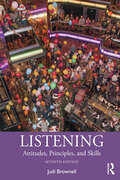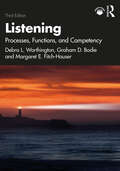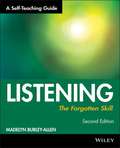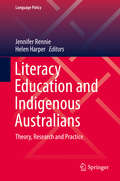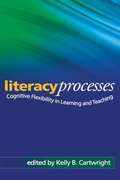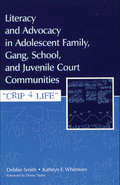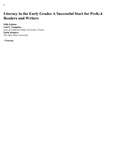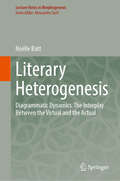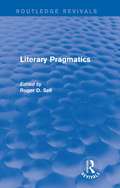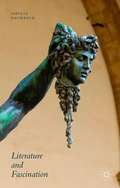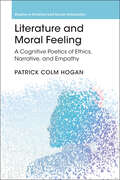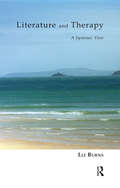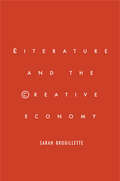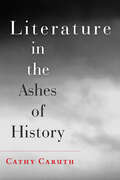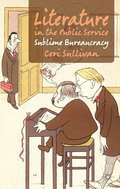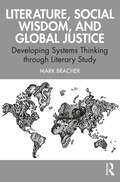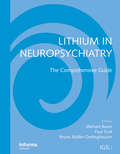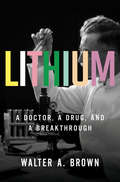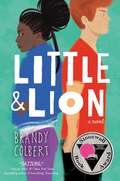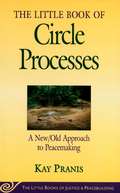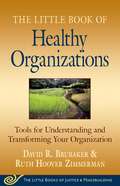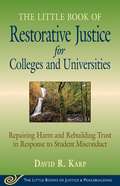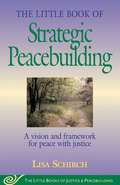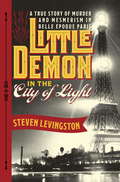- Table View
- List View
Listening: Attitudes, Principles, and Skills
by Judi BrownellProvides an applied, experiential approach to listening instruction with special attention to interpersonal, family, professional, educational, and health contexts Market leading text for Listening courses in Communication, with additional application for management, education, and human resources courses Text contains practical features including case studies, exercises, discussion questions, and journal assignments --Online resources include PowerPoint slides and exercises
Listening: Processes, Functions, and Competency
by Debra L. Worthington Margaret E. Fitch-Hauser Graham D. BodieThis fully revised third edition explores the essential role of listening to human communication across contexts and cultures.Based on the premise that listening is a goal-directed activity, this book blends theory with practical application and builds knowledge, insight, and skills to help the reader become a more effective listener. In this new edition, theory and research has been updated with an emphasis on how the growing reliance on mediated communication affects how individuals communicate in their personal, professional, and educational lives. It introduces students to emerging concepts and methods such as neurodiversity and fMRI as well as evolving professional and educational contexts including aural architecture and "the musical brain".Addressing listening as a cognitive process, social function, and critical professional competency, this is an essential textbook for undergraduate courses in listening and communication studies.In addition to a fully updated instructor’s manual containing discussion questions, activities and assignments, and exam questions, this new edition includes PowerPoint slides and videos. They are available at http://www.routledge.com/9781032491257.
Listening: The Forgotten Skill (A Self-Teaching Guide), Second Edition
by Madelyn Burley-AllenA proven program for turning effective listening into a powerful business tool Managers and other employees spend more than 40 percent of their time listening to other people but often do it so poorly that the result is misunderstood instructions, misdirected projects, and erroneous actions--millions of dollars' worth of mistakes just because most people don't know how to listen. In this new edition of her classic guide to the art of effective listening, Madelyn Burley-Allen shows you how to acquire active, productive listening skills and put them to work for you--professionally, socially, and personally. With her time-tested techniques, you'll learn how to:<p><p> * Eliminate distractions and improve your concentration on what is being said<br> * Locate key words, phrases, and ideas while listening<br> * Cut through your own listening biases<br> * Interpret body language clues<br> * Ask constructive, nonthreatening questions that elicit real information<br> * Get others to listen to you<br> * Master a whole range of listening skills that you can use on the job and in your personal life<p> Listening: The Forgotten Skill uses an interactive learning approach with work-sheets, charts, graphs, and self-tests that help you pace and monitor your own progress.
Literacy Education and Indigenous Australians: Theory, Research and Practice (Language Policy #19)
by Jennifer Rennie Helen HarperThis edited volume brings together diverse perspectives on Australian literacy education for Indigenous peoples, highlighting numerous educational approaches, ideologies and aspirations. The Australian Indigenous context presents unique challenges for educators working across the continent in settings ranging from urban to remote, and with various social and language groups. Accordingly, one of the book’s main goals is to foster dialogue between researchers and practitioners working in these contexts, and who have vastly different theoretical and ideological perspectives. It offers a valuable resource for academics and teachers of Indigenous students who are interested in literacy-focused research, and complements scholarship on literacy education in comparable Indigenous settings internationally.
Literacy Processes
by Gedeon O. Deak Kelly B. CartwrightReading and writing instruction require individuals--both students and teachers--to flexibly process many kinds of information, from a variety of sources. This is the first book to provide an in-depth examination of cognitive flexibility: how it develops across the lifespan; its role in specific literacy processes, such as phonemic awareness, word recognition, and comprehension; and implications for improving literacy instruction and teacher education. The contributors include leading researchers in literacy, psychology, and cognitive development, who summarize the current state of the science and offer practical suggestions for fostering cognitive flexibility in learners of all ages.
Literacy and Advocacy in Adolescent Family, Gang, School, and Juvenile Court Communities: Crip 4 Life
by Kathryn F. Whitmore Debra SmithThe goal of this book is to encourage educators and researchers to understand the complexities of adolescent gang members' lives in order to rethink their assumptions about these students in school. The particular objective is to situate four gang members as literate, caring students from loving families whose identities and literacy keep them on the margins of school. The research described in this book suggests that advocacy is a particularly effective form of critical ethnography. Smith and Whitmore argue that until schools, as communities of practice, enable children and adolescents to retain identities from the communities in which they are full community members, frightening numbers of students are destined to fail.The stories of four Mexican American male adolescents, who were active members of a gang and Smith's students in an alternative high school program, portray the complicated, multiple worlds in which these boys live. As sons and teenage parents they live in a family community; as CRIP members they live in a gang community; as "at risk" students, drop-outs, and graduates they live in a school community, and as a result of their illegal activities they live in the juvenile court community. The authors theorize about the boys' literacy in each of their communities. Literacy is viewed as ideological, related to power, and embedded in a sociocultural context. Vivid examples of conversation, art, tagging, rap, poetry, and other language and literacy events bring the narratives to life in figures and photographs in all the chapters. Readers will find this book engaging and readable, yet thought provoking and challenging.Audiences for Literacy and Advocacy in Adolescent Family, Gang, School, and Juvenile Court Communities include education researchers, professionals, and students in the areas of middle/high school education, at-risk adolescent psychology, and alternative community programs--specifically those interested in literacy education, sociocultural theory, and popular culture.
Literacy in the Early Grades: A Successful Start For PreK-4 Readers and Writers
by Gail Tompkins Emily RodgersA practical and balanced approach to helping young students become fluent readers and writers Literacy in the Early Grades: A Successful Start for PreK-4 Readers and Writers presents a balanced approach to literacy instruction that will help all young students make a successful start in reading and writing. <p><p>Effective teachers know their students’ individual needs, and use their understanding of literacy development to guide their teaching. The 5th Edition provides the background knowledge, modeling, and practical resources – including authentic classroom vignettes, student work samples, minilessons, assessment tools, and a Compendium of Instructional Procedures – that will ensure you are well prepared to meet grade-level standards and lead young students to become fluent readers and writers.
Literary Heterogenesis: Diagrammatic Dynamics. The Interplay Between the Virtual and the Actual (Lecture Notes in Morphogenesis)
by Noëlle BattThis book advances a new interdisciplinary approach that engages with the concepts of science and literature through the mediation of philosophy (with a focus on the ideas of Gilbert Simondon and Gilles Deleuze). It investigates in innovative ways the multifaceted dimensions of creation, of genesis, considered here in artistic and mathematical terms as “heterogenesis”. The dialogic interaction among the three domains generates a renewed analysis of poems selected in the work of particularly inventive poets, both French and American—Emily Dickinson, e.e. cummings and Francis Ponge—as well as the artwork of Pierre Soulages, Anna-Eva Bergman and Cy Twombly. Literary Heterogenesis. Diagrammatic Dynamics. The Interplay of the Virtual and the Actual will interest specialists of mathematics, physics, literary theory and criticism, philosophy, and epistemology. It will also attract any curious mind drawn to the bridging of disciplines and the concepts of the two cultures.
Literary Pragmatics: Criticism, Theory, Education. Selected Papers 1985-2002 (Routledge Revivals #10)
by Roger D. SellUp until the mid-1980s most pragmatic analysis had been done on spoken language use, considerably less on written use, and very little at all on literary activity. This has now radically changed. ‘Pragmatics’ could be informally defined as the study of relationships between language and its users. This volume, first published in 1991, seeks to reposition literary activity at the centre of that study. The internationally renowned contributors draw together two main streams. On the one hand, there are concerns which are close to the syntax and semantics of mainstream linguistics, and on the other, there are concerns ranging towards anthropological linguistics, socio- and psycholinguistics. Literary Pragmatics represents an antidote to the fragmenting specialization so characteristic of the humanities in the twentieth century. This book will be of lasting value to students of linguistics, literature and society. Roger D. Sell discusses the reissue of Literary Pragmatics here: http://www.routledge.com/articles/roger_d._sell_discusses_the_reissue_of_literary_pragmatics/
Literature and Fascination
by Sibylle BaumbachThis book explores literary fascination. Why do some texts capture us more than others; how do concepts of fascination evolve; what part does literature play in this; and how can literary fascination be pinpointed and conceptualised? Offering detailed case studies that include texts by William Shakespeare, S.T. Coleridge, Mary Shelley, Bram Stoker, Oscar Wilde, Joseph Conrad, Don DeLillo, and Ian McEwan, this study investigates various mechanisms of fascination across different verbal media of attraction. It illuminates the ways in which these texts are designed, presented, and received and develops fascination as a key concept of aesthetic attraction that provides insight into our understanding of how perception functions with regard to literature and how it has evolved. Synthesizing these analyses, the book argues that narratives of fascination essentially work with medusamorphosis, a concept that takes its cue from the Gorgon Medusa and aids the analysis of key mechanisms used to elicit fascination.
Literature and Moral Feeling: A Cognitive Poetics of Ethics, Narrative, and Empathy (Studies in Emotion and Social Interaction)
by Patrick Colm HoganAn influential body of recent work on moral psychology has stressed the interconnections among ethics, narrative, and empathy. Yet as Patrick Colm Hogan argues, this work is so vague in its use of the term 'narrative' as to be almost substanceless, and this vagueness is in large part due to the neglect of literary study. Extending his previous work on universal story structures, Hogan argues that we can transform ill-defined intuitions about narrative and ethics into explicit and systematic accounts of the deep connections between moral attitudes and narratives. These connections are, in turn, inseparable from empathy, a concept that Hogan proceeds to clarify and defend against a number of widely read critiques. In the course of the book, Hogan develops and illustrates his arguments through analyses of global narratives, constructing illuminating ethical interpretations of literary works ranging from Shakespeare to Chinese drama and the Bhagavad Gita.
Literature and Therapy: A Systemic View
by Liz BurnsLiterature and Therapy: A Systemic View is an invitation to the world of literature, drawing us into the creative and imaginative spaces which lie between readers and their choice of novels, plays and poems. In this world, the fundamental importance of emotion and intuition is recognised, as is the power of literature to promote transformations of meaning in every day life and in therapeutic practice. Its potential to contribute depth and diversity to therapists' personal/professional development is explored via literary reflections and qualitative research findings. The author defines the terms literature and therapy broadly, emphasising their mutual relevance in contemporary and historical contexts, acknowledging the richness of literary resources and signposting accessible routes to their use in clinical practice. A systemic view, highlighting relationships, calls to the reader to explore both therapy and literature with fresh eyes, newly motivated thoughts and a lightening heart.
Literature and the Creative Economy
by Sarah BrouilletteFor nearly twenty years, social scientists and policy makers have been highly interested in the idea of the creative economy. This book contends that mainstream considerations of the economic and social force of culture, including theories of the creative class and of cognitive and immaterial labor, are indebted to historic conceptions of the art of literary authorship. What's more, it shows how contemporary literature has been involved in and has responded to creative-economy phenomena, including the presentation of artists as models of contentedly flexible and self-managed work, the treatment of training in and exposure to art as a pathway to social inclusion, the use of culture and cultural institutions to increase property values, and support for cultural diversity as a means of growing cultural markets. Contemporary writers have not straightforwardly bemoaned these phenomena in a classic rejection of the instrumental application of art. Rather, they have tended to explore how their own critical capacities have become compatible with or even essential to a neoliberal economy that has embraced art's autonomous gestures as proof that authentic self-articulation and social engagement can and should occur within capitalism. Taking a sociological approach to literary criticism, Brouillette interprets major works of contemporary fiction by Monica Ali, Aravind Adiga, Daljit Nagra, and Ian McEwan alongside government policy, social science, and theoretical explorations of creative work and immaterial labor.
Literature in the Ashes of History
by Cathy CaruthWhat does it mean for history to disappear?Outstanding Academic Title, ChoiceCathy Caruth juxtaposes the writings of psychoanalysts, literary and political theorists, and literary authors who write in a century faced by a new kind of history, one that is made up of events that seem to undo, rather than produce, their own remembrance. At the heart of each chapter is the enigma of a history that, in its very unfolding, seems to be slipping away before our grasp. What does it mean for history to disappear? And what does it mean to speak of a history that disappears? These questions, Caruth suggests, lie at the center of the psychoanalytic texts that frame this book, as well as the haunting stories and theoretical arguments that resonate with each other in profound and surprising ways. In the writings of Honoré de Balzac, Hannah Arendt, Ariel Dorfman, Wilhelm Jensen, Sigmund Freud, and Jacques Derrida, we encounter, across different stakes and different languages, a variety of narratives that bear witness not simply to the past but also to the pasts we have not known and that repeatedly return us to a future that remains beyond imagination.These stories of trauma cannot be limited to the catastrophes they name, and the theory of catastrophic history may ultimately be written in a language that already lingers in a time that comes to us from the other side of the disaster.
Literature in the Public Service
by Ceri SullivanHistorians and sociologists have been consistently - albeit gloomily - enthralled by Max Weber's model of the inevitable rise of the neurocrat. However, literary critics positively boast that writers, like academics, cannot 'do admin'. While Weber's thesis about the rise of the entrepreneur all fire, individuality, thrust is in tune with what we think literature is about, his thesis about the rise of the bureaucrat is not. Yet 'creative bureaucracy' is not only a euphemism for bending the rules. Literature in the Public Service shows how the public service makes its workers original, taking them beyond an individuated point of view to imagine the perfect public system. Creativity theorists too have swapped the model of solitary inspiration for a managed creative environment. John Milton, Anthony Trollope, and David Hare are examples of how authors work in and write about the public service, during its crisis moments. "
Literature, Social Wisdom, and Global Justice: Developing Systems Thinking through Literary Study
by Mark BracherThis book responds to the pressing and increasingly recognized need to cultivate social wisdom for addressing major problems confronting humanity. Connecting literary studies with some of the biggest questions confronted by researchers and students today, the book provides a practical approach to thinking through, and potentially solving, global problems such as poverty, inequality, crime, war, racism, classism, environmental decline, and climate change. Bracher argues that solving such problems requires “systems thinking” and that literary study is an excellent way to develop the four key cognitive functions of which systems thinking is composed, which are causal analysis, prospection/strategic planning, social cognition, and metacognition. Drawing on evidence-based learning theory, as well as the latest research on systems thinking and its four cognitive functions, the book provides a comprehensive and detailed explanation of how these advanced thinking skills can be developed through literary study, illustrating the process with numerous examples from major works of literature. In explaining the nature and importance of these thinking skills and the ability of literary study to develop them, this book will be of value to literature teachers and students from introductory to advanced levels, and to anyone looking to develop better problem-solving and decision-making skills.
Lithic Technological Systems and Evolutionary Theory
by Nathan Goodale William Andrefsky Jr.Stone tool analysis relies on a strong background in analytical and methodological techniques. However, lithic technological analysis has not been well integrated with a theoretically-informed approach to understanding how humans procured, made, and used stone tools. Evolutionary theory has great potential to fill this gap. This collection of essays brings together several different evolutionary perspectives to demonstrate how lithic technological systems are a byproduct of human behavior. The essays cover a range of topics, including human behavioral ecology, cultural transmission, phylogenetic analysis, risk management, macroevolution, dual inheritance theory, cladistics, central place foraging, costly signaling, selection, drift, and various applications of evolutionary ecology.
Lithium in Neuropsychiatry: The Comprehensive Guide
by Michael Bauer Paul Grof Bruno Müller-OerlinghausenThe definitive textbook on the use of lithium in the treatment of mental disorders, this comprehensive work provides an up-to-date analysis of lithium, including:HistoryClinical applications, including its use for mania, bipolar and schizophrenic disordersUse in special populations, for example in children, the elderly and people with med
Lithium: A Doctor, A Drug, And A Breakthrough
by Walter A. BrownThe remarkable untold story of a miracle drug, the forgotten pioneer who discovered it, and the fight to bring lithium to the masses. The DNA double helix, penicillin, the X-ray, insulin—these are routinely cited as some of the most important medical discoveries of the twentieth century. And yet, the 1949 discovery of lithium as a cure for bipolar disorder is perhaps one of the most important—yet largely unsung—breakthroughs of the modern era. In Lithium, Walter Brown, a practicing psychiatrist and professor at Brown, reveals two unlikely success stories: that of John Cade, the physician whose discovery would come to save an untold number of lives and launch a pharmacological revolution, and that of a miraculous metal rescued from decades of stigmatization. From insulin comas and lobotomy to incarceration to exile, Brown chronicles the troubling history of the diagnosis and (often ineffective) treatment of bipolar disorder through the centuries, before the publication of a groundbreaking research paper in 1949. Cade’s “Lithium Salts in the Treatment of Psychotic Excitement” described, for the first time, lithium’s astonishing efficacy at both treating and preventing the recurrence of manic-depressive episodes, and would eventually transform the lives of patients, pharmaceutical researchers, and practicing physicians worldwide. And yet, as Brown shows, it would be decades before lithium would overcome widespread stigmatization as a dangerous substance, and the resistance from the pharmaceutical industry, which had little incentive to promote a naturally occurring drug that could not be patented. With a vivid portrait of the story’s unlikely hero, John Cade, Brown also describes a devoted naturalist who, unlike many modern medical researchers, did not benefit from prestigious research training or big funding sources (Cade’s “laboratory” was the unused pantry of an isolated mental hospital). As Brown shows, however, these humble conditions were the secret to his historic success: Cade was free to follow his own restless curiosity, rather than answer to an external funding source. As Lithium makes tragically clear, medical research—at least in America—has transformed in such a way that serendipitous discoveries like Cade’s are unlikely to occur ever again. Recently described by the New York Times as the “Cinderella” of psychiatric drugs, lithium has saved countless of lives and billions of dollars in healthcare costs. In this revelatory biography of a drug and the man who fought for its discovery, Brown crafts a captivating picture of modern medical history—revealing just how close we came to passing over this extraordinary cure.
Little & Lion
by Brandy ColbertA stunning novel on love, loss, identity, and redemption, from Publishers Weekly Flying Start author Brandy Colbert. When Suzette comes home to Los Angeles from her boarding school in New England, she isn't sure if she'll ever want to go back. L.A. is where her friends and family are (along with her crush, Emil). And her stepbrother, Lionel, who has been diagnosed with bipolar disorder, needs her emotional support.But as she settles into her old life, Suzette finds herself falling for someone new...the same girl her brother is in love with. When Lionel's disorder spirals out of control, Suzette is forced to confront her past mistakes and find a way to help her brother before he hurts himself--or worse. <br> <b>Winner of the 2018 Stonewall Book Award</b>
Little Book of Circle Processes: A New/Old Approach To Peacemaking
by Kay PranisOur ancestors gathered around a fire in a circle, families gather around their kitchen tables in circles, and now we are gathering in circles as communities to solve problems. The practice draws on the ancient Native American tradition of a talking piece. Peacemaking Circles are used in neighborhoods to provide support for those harmed by crime and to decide sentences for those who commit crime, in schools to create positive classroom climates and resolve behavior problems, in the workplace to deal with conflict, and in social services to develop more organic support systems for people struggling to get their lives together. A title in The Little Books of Justice and Peacebuilding Series.
Little Book of Healthy Organizations: Tools For Understanding And Transforming Your Organization (Little Books Of Justice And Peacebuilding Ser.)
by David BrubakerThe best way to change the world may be one organization at a time. With this ambitious claim, the authors of this highly readable primer provide insightful analysis for evaluating and improving the health of any organization. They advocate a "systems approach," which views organizations as living systems, interconnected in their various departments, and interfacing with their environments. Leaders of organizations from all sectors will find sound advice concerning the four major components of organizations -- their structure, leadership, culture, and environment. Find out: What the classic dispute over "who gets the corner office" is really about. The difference between a good leader and a great one. What new hires may know about an organization that longer-term employees don't. How organizational change and conflict are not only inevitable, but survivable. Each chapter contains examples from the authors' varied experiences with organizational change and conflict, written from a spirited, hopeful approach for creating a better world. A title in The Little Books of Justice and Peacebuilding Series.
Little Book of Restorative Justice for Colleges & Universities: Revised & Updated
by David KarpHere’s a call to colleges and universities to consider implementing restorative practices on their campuses, ensuring fair treatment of students and staff while minimizing institutional liability, protecting the campus community, and boosting morale. From an associate dean of student affairs who has put these models to work on his campus. Restorative justice is a collaborative decision-making process that includes victims, offenders, and others who are seeking to hold offenders accountable by having them (a) accept and acknowledge responsibility for their offenses, (b) to the best of their ability, repair the harm they caused to victims and communities, and (c) work to reduce the risk of re-offense by building positive social ties to the community. David Karp writes in his introduction, "As a student affairs administrator, I have become deeply committed to the concept and practice of restorative justice. I have experienced how it can work given the very real pressures among campus conduct administrators to manage high case loads, ensure fair treatment, minimize institutional liability, protect the campus community, boost morale in a division with high turnover, and help students learn from their mistakes without creating insurmountable obstacles to their future successes. "
Little Book of Strategic Peacebuilding: A Vision And Framework For Peace With Justice (Justice and Peacebuilding)
by Lisa ShirchSo we'd all like a more peaceful world-no wars, no poverty, no more racism, no community disputes, no office tensions, no marital skirmishes. Lisa Schirch sets forth paths to such realities.<P><P> In fact, she points a way to more than the absence of conflict. She foresees justpeace-a sustainable state of affairs because it is a peace which insists on justice. Schirch singles out four critical actions that must be undertaken if peace is to take root at any level) - 1.) waging conflict nonviolently; 2.) reducing direct violence; 3.) transforming relationships; and 4.) building capacity. From Schirch's 15 years of experience as a peacebuilding consultant in Africa, Asia, and Latin America. A title in The Little Books of Justice and Peacebuilding Series.
Little Demon in the City of Light
by Steven LevingstonA delicious account of a murder most gallic--think CSI Paris meets Georges Simenon--whose lurid comibation of sex, brutality, forensics, and hypnotism riveted first a nation and then the world.Little Demon in the City of Light is the thrilling--and so wonderfully French--story of a gruesome 1889 murder of a lascivious court official at the hands of a ruthless con man and his pliant mistress and the international manhunt, sensational trial, and an inquiry into the limits of hypnotic power that ensued.In France at the end of the nineteenth century a great debate raged over the question of whether someone could be hypnotically compelled to commit a crime in violation of his or her moral convictions. When Toussaint-Augustin Gouffé entered 3, rue Tronson du Coudray, he expected nothing but a delightful assignation with the comely young Gabrielle Bompard. Instead, he was murdered--hanged!--by her and her companion Michel Eyraud. The body was then stuffed in a trunk and dumped on a riverbank near Lyon.As the inquiry into the guilt or innocence of the woman the French tabloids dubbed the "Little Demon" escalated, the most respected minds in France debated whether Gabrielle Bompard was the pawn of her mesmerizing lover or simply a coldly calculating murderess. And, at the burning center of it all: Could hypnosis force people to commit crimes against their will?
